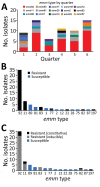Emergence of Erythromycin-Resistant Invasive Group A Streptococcus, West Virginia, USA, 2020-2021
- PMID: 37080963
- PMCID: PMC10124663
- DOI: 10.3201/eid2905.221421
Emergence of Erythromycin-Resistant Invasive Group A Streptococcus, West Virginia, USA, 2020-2021
Abstract
Clindamycin and β-lactam antibiotics have been mainstays for treating invasive group A Streptococcus (iGAS) infection, yet such regimens might be limited for strains displaying MLSB phenotypes. We investigated 76 iGAS isolates from 66 patients in West Virginia, USA, during 2020-2021. We performed emm typing using Centers for Disease Control and Prevention guidelines and assessed resistance both genotypically and phenotypically. Median patient age was 42 (range 23-86) years. We found 76% of isolates were simultaneously resistant to erythromycin and clindamycin, including all emm92 and emm11 isolates. Macrolide resistance was conferred by the plasmid-borne ermT gene in all emm92 isolates and by chromosomally encoded ermA, ermB, and a single mefA in other emm types. Macrolide-resistant iGAS isolates were typically resistant to tetracycline and aminoglycosides. Vulnerability to infection was associated with socioeconomic status. Our results show a predominance of macrolide-resistant isolates and a shift in emm type distribution compared with historical reports.
Keywords: Streptococcus pyogenes; United States; West Virginia; antimicrobial resistance; bacteria; clindamycin; constitutive; drug resistance; emm92; erythromycin; inducible; invasive group A Streptococcus; streptococci.
Figures




References
Publication types
MeSH terms
Substances
LinkOut - more resources
Full Text Sources
Medical

